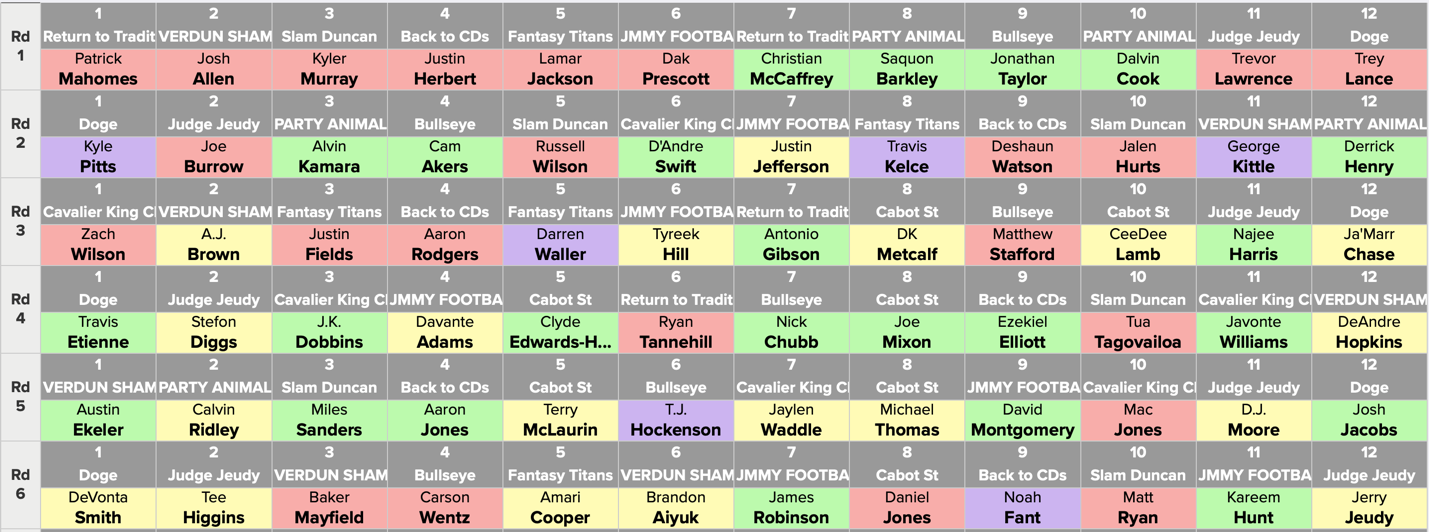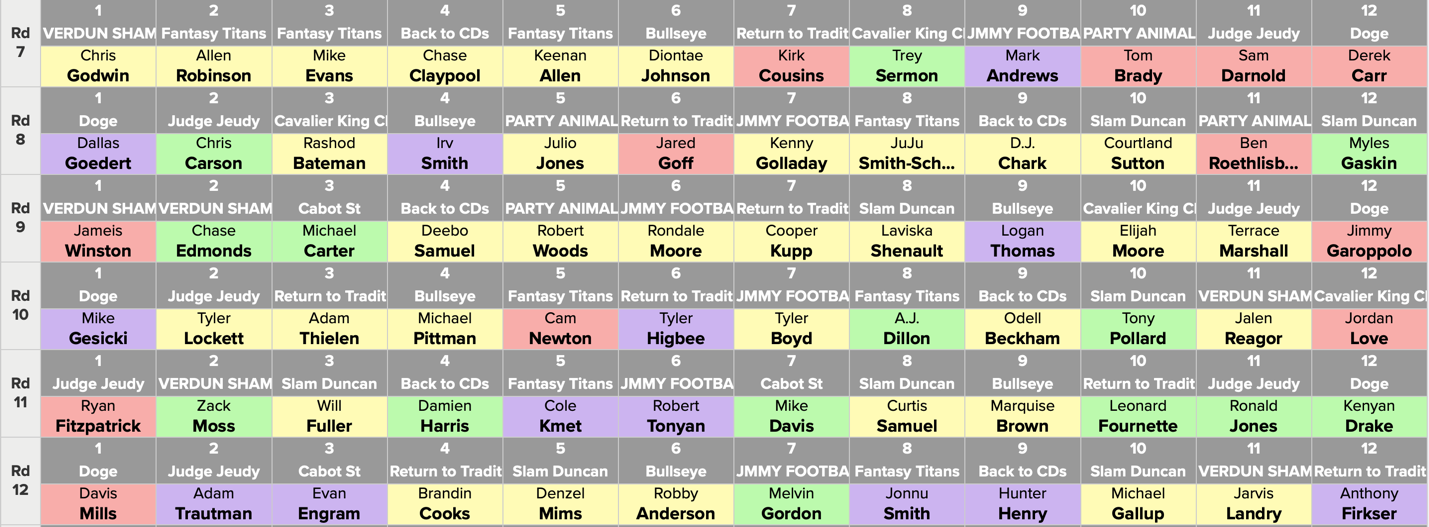Drafting ‘All-22’ in a $500 FFPC Dynasty Startup Draft

Editor’s note: This article is by Member Corner writer Norm Cruz. Please welcome Norm and provide constructive feedback in the comments section.
There is drafting young, and then there’s drafting ‘All-22’ young. In this article, I will examine what it looks like to draft a dynasty team exclusively of players 22 and younger in a 2021 $500 FFPC Superflex Best Ball Dynasty startup draft.
I am Norm Cruz, also known as Cavalier King Charles in the high stakes dynasty community. I am a long-time dynasty player and was the first in the FFPC to reach $100,000 in career gross dynasty earnings back in 2019.
Playing dynasty for me is a for-profit business, so I am always looking for the best way to draft a startup dynasty team for the most long-term gain. Like many, my goal in startups is to build a team that can stay young, avoid long rebuild scenarios and of course, win money. In 2021 (as it was in 2020), drafting a team exclusively of players 22 and younger may just be the best strategy of them all.
League Setup:
This league is a Superflex PPR dynasty league (TE premium) that starts 1 QB, 2 RBs, 3 WRs, 1 Superflex, and 2 regular flex positions. This is a Best Ball league, meaning you don’t have to set a lineup week to week as the software will automatically set your optimal lineup after each week is played.
Basic Plan:
The overall plan is to draft only 22-(or 21-)year-old players regardless of other players on the board with potentially higher perceived values. While it may be extremely tempting to take another older player who presents huge value at a particular draft pick, I’ve learned from past mistakes that staying disciplined and taking the appropriate 22-year-old is the best approach.
Why draft so young? In a nutshell, drafting players 22 and under gives the best chance for a team to peak in value and strength in year three while still maintaining dynasty values for several years after (so you can trade, rinse and repeat). The short-term goal (years one-three) is to dominate in year three while potentially winning a championship as early as year two.
The Draft:
Here is the draft board as it played out (through 18 rounds, look out for Cavalier King Charles):



The chart can be confusing because it is a snake draft, but reads left to right for each round. For example, Derrick Henry was the 2.12 pick (not the 2.1). I started in the 1.1 slot and made several trades for better positioning and to pick up three 2022 first-rounders (for four total) along with an additional 2022 second-rounder.
Here is my team:
- QB Zach Wilson (August 1999) at 3.1
- QB Mac Jones (September 1998) at 5.10
- QB Jordan Love (November 1998) at 10.12
- RB D’Andre Swift (January 1999) at 2.6
- RB JK Dobbins (December 1998) at 4.3
- RB Javonte Williams (April 2000) at 4.11
- RB Trey Sermon (January 1999) at 7.8
- WR Jaylen Waddle (November 1998) at 5.7
- WR Rashod Bateman (November 1999) at 8.3
- WR Elijah Moore (March 2000) at 9.11
- WR Henry Ruggs (January 1999) at 13.01
- WR Tutu Atwell (October 1999) at 21.01
- WR Tylan Wallace (May 1999) at 22.12
- WR Jaelon Darden (January 1999) at 23.01
- WR Seth Williams (April 2000) at 25.08
- WR Jalen Camp (July 1998) at 26.05
- WR Jonathan Adams (January 1999) at 26.12
- TE Tommy Tremble (June 2000) at 18.12
- TE Tre’ McKitty (January 1999) at the 20.12
- Future Picks: Four 2022 first-rounders and two second-rounders
One way I like to evaluate my startup teams is projecting what they might have in year two in terms of startup value. Here, I project Swift to be a first in 2022, and Dobbins a second (or vice versa). I project Wilson to be a first-rounder (late) as well. I have Williams as a third. Sermon and Jones would be fourth-rounders, Waddle a fifth, and Bateman, Moore, and Love each an eighth.
I project the future first-rounders to be the 1.1, 1.3, 1.7, and 1.8 (startup value of a second, second, fifth and fifth). Based on these projections, the team in 2022 would have startup values equivalent to two first-rounders, three seconds, one third, two fourths, three fifths, and three eighths. That would be five players in the first two rounds, eight in the first four rounds, and fourteen players in the first eight rounds. These projections may be optimistic for some of the players, but others might outperform, and in any case, the huge potential is evident.
Still, just looking at the roster, it may be difficult to get a feel for how good this team really could be. To get a better sense, we can look at how similarly constructed All-22 teams in 2020 turned out in 2021.
2020 All-22 Startup Teams:
“2020 Team 1” is a team I drafted in a $500 FFPC Superflex Dynasty Best Ball in 2020. QB-2RB-2WR-TE-2 Flex (one of which may be QB). This team left the startup draft with five future first-rounders (including my own). Here are the notable players on that team as of May 2021 just after the rookie draft.
- QB Dak Prescott (acquired via trade in-season following major injury)
- QB Trevor Lawrence (Rookie 1.1)
- QB Zach Wilson (Rookie 1.4)
- RB Jonathan Taylor (2.4)
- RB D’Andre Swift (3.1)
- RB JK Dobbins (2.12)
- RB Travis Etienne (Rookie 1.5)
- RB Javonte Williams (Rookie 1.9)
- WR Justin Jefferson (8.10)
- WR Tee Higgins (12.4)
- WR Chase Claypool (17.9)
- WR Ja’Marr Chase (Rookie 1.8)
- WR Michael Pittman (11.4)
- WR Amari Cooper (4.12)
- TE Dallas Goedert (8.12)
- TE Cole Kmet (16.9)
- TE Adam Trautman (15.9)
- Future Picks: Three (3) 2022 First Rounders
Estimated Finish: Favorite to win in 2021 (year two), heavy favorite to win in 2022 (year three)
Note that the drafting of Amari Cooper was a good example of why it is important to stay disciplined if you are employing this type of strategy. On the clock at the 4.12, I opted to draft the value veteran who was “too good” to pass up when the next 22 on my list would have been CeeDee Lamb whose ADP was another 6-12 picks away. I reasoned that I could trade Cooper for Lamb early in the season and maybe even pick up something extra. Wrong, and lesson learned.
This team is clearly a powerhouse with the help of having hit big on Jefferson and Claypool. This represents what may be the very high end of the results you can reasonably expect employing the All-22.
“2020 Team 2”, another $500 FFPC Superflex Dynasty Best Ball team that I drafted in 2020, represents what may be a more realistic expectation for this strategy. This team left the startup draft with six future first-rounders (including my own). Here are the notable players on that team (post rookie draft) in 2021.
- QB Joe Burrow (3.10)
- QB Tua Tagovailoa (4.3)
- QB Trevor Lawrence (Rookie 1.1)
- QB Zach Wilson (Rookie 1.8)
- RB Jonathan Taylor (2.3)
- RB Clyde Edwards-Helaire (2.1)
- RB Travis Etienne (Rookie 1.7)
- RB Najee Harris (Rookie 1.3)
- RB Trey Sermon (Rookie 2.1)
- RB Myles Gaskin (FAAB)
- WR Tee Higgins (10.3)
- WR Jerry Jeudy (via trade)
- WR Jaylen Waddle (Rookie 1.11)
- WR DeVonta Smith (Rookie 1.10)
- WR Corey Davis (FAAB)
- TE Cole Kmet (FAAB)
- TE Harrison Bryant (19.10)
Estimated Finish: Competitive in 2021 (year two), heavy favorite to win in 2022 (year three)
This team lacks the jackpots of Jefferson and Claypool that 2020 Team 1 had, and a number of the picks like Edwards-Helaire and Tagovailoa under-performed relative to my projections. And yet, I feel like this team is still a ridiculously good dynasty team by brute force of the strategy itself.
Part of the reason 2020 Team 2 may have lacked the big winners of 2020 Team 1 is that it started out with more 2021 firsts which limited the number of mid-draft lottery tickets I was able to draft. That extra first or two could have contributed to missing out on Jefferson and/or Gibson as an example. For 2021, I am thinking that three-five future first-rounders may be the sweet spot in the All-22 so that you still have enough maiden draft picks to take advantage of the current crop of 22s.
For a final comparison, “2020 Team 3” is a non-superflex team I drafted in a $250 FFPC Dynasty Best Ball employing the All-22. QB-2RB-2WR-TE-2Flx. This team had only three future firsts (including my own) coming out of the startup draft in 2020.
- QB Justin Herbert (13.10)
- RB Jonathan Taylor (2.3)
- RB D’Andre Swift (3.2)
- RB Antonio Gibson (8.3)
- RB Travis Etienne (Rookie 1.3)
- RB Javonte Williams (Rookie 1.4)
- WR DK Metcalf (4.3)
- WR CeeDee Lamb (5.7)
- WR Justin Jefferson (5.10)
- WR Tee Higgins (10.3)
- WR Jaylen Waddle (Rookie 1.8)
- WR Jalon Reagor (6.3)
- WR Henry Ruggs (6.11)
- TE Noah Fant (7.10)
- TE Harrison Bryant (22.3)
Estimated Finish: Among the favorites to win in 2021 (year two), heavy favorite to win in 2022 (year three)
Who wouldn’t want a team that looked like this after year one?
All three of these 2020 comparison teams are primed to win, if not in year two, then in year three (and beyond). After year three, the vast majority of the players on these teams will be only 24! At that point, I would be looking to cycle some of the 24s back to 22s and future firsts to keep the team rolling indefinitely.
Comparing this year’s All-22 team to these 2020 teams, this year’s team is very similar in construction, start quality, and projected trajectory. Due to the quality of the 22s this year, I think the results from 2020 can absolutely be repeated in 2021. While the 2022 rookie draft is unlikely to yield as many home runs as the 2021 or 2020 drafts, I don’t think that will make an appreciable difference for purposes of this strategy. I should still be able to fill holes through the rookie draft next year and add a few more potentially elite players, which next year won’t seem fair to the rest of the league.
This is not to say that simply picking all 22 year-olds and acquiring a handful of future firsts in itself is some magic formula that will result in a powerhouse team. In addition to some luck, you will still need to position yourself throughout the startup draft, make the right adjustments, pick the right players, acquire the right firsts, make the right trades, and do all the things good dynasty players do to maximize their teams.
However, I believe that this is the strongest play this year and is incredibly fun regardless, whether or not the results are the same. Employing the same strategy in startups next year may be more difficult depending on the quality of next year’s 22-year-old player pool, but I’ll deal with next year when it comes. For this year, this is the strategy I’ll be employing all summer.


































































